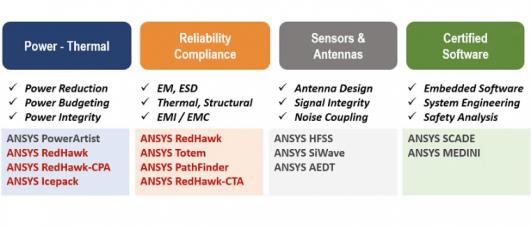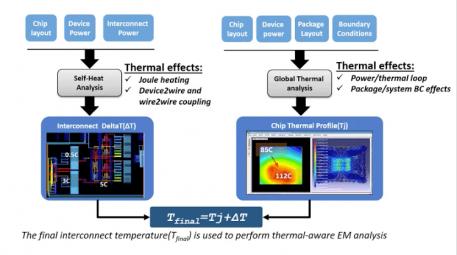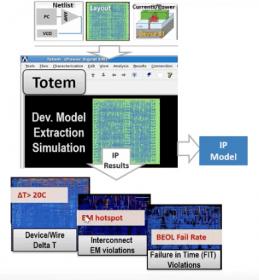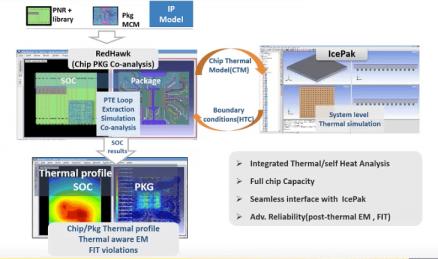Ansys recently hosted a webinar on reliability signoff for FinFET-based designs, spanning thermal, EM, ESD, EMC and aging effects. I doubt you’re going to easily find a more comprehensive coverage of reliability impact and analysis solutions. If you care about reliability in FinFET designs, you might want to check out this webinar. It covers a lot of ground, so much that I’ll touch only on aspects of thermal analysis here with just a few hints to the other topics. The webinar covers domains with products highlighted in red below.
 Incidentally, ANSYS and TSMC are jointly presenting on this topic at ARM TechCon. You can get a free Expo pass which will let you into this presentation HERE.
Incidentally, ANSYS and TSMC are jointly presenting on this topic at ARM TechCon. You can get a free Expo pass which will let you into this presentation HERE.
Why is reliability a big deal in FinFET-based designs? There are multiple issues impacting aging, stress and other factors, but one particular issue should by now be well-known – the self-heating problem in FinFET devices. In planar devices, heat generated inside a transistor can escape largely through the substrate. But in a FinFET, dielectric is wrapped around the fin structure and, since dielectrics generally are poor thermal conductors, heat can’t as easily escape leading to a local temperature increase, and will ultimately escape significantly through local interconnect leading to additional heating in that interconnect.

Also, since FinFETs are built for high drive strength, they are driving more current through thinner interconnect resulting in more Joule heating. In addition to these effects, you have to consider the standard sources of heating, thanks to complex IP activity profiles in modern SoCs: active, idle, sleep modes and power off – all of which contribute to a heat map across the die which will vary with use-cases. Self-heating effects may contribute 5[SUP]o[/SUP] or more in variation and use-case effects may contribute 30[SUP]o[/SUP] or more across the die.
An accurate analysis has to take both these factors into account to meaningfully assess reliability impact. Typical margin-based (across the die) approaches are ineffective and lead to grossly uneconomic overdesign. Which of course would next take us into the big data and SeaScape topic but I’m not going to talk about that here. In this webinar Ansys’ focus is the reliability analysis.

The thermal reliability workflow starts with Totem-CTA for analysis of AMS or custom blocks. This is based on a transient simulation and library models to determine local heating, EM violations and FIT violations. Totem will also build a model for the block which you can then use in the next step.

RedHawk-CTA will analyze digital IPs and the full chip-package system in a power-thermal-electrical loop simulation to determine temperature profiles by use-case, along with thermal-aware EM and FIT violations. You probably know from my previous posts that it can also do this for 2.5D and 3D systems. Out of all of this, RedHawk-CTA tool will generate a model which can be used in system level analysis using Ansys IcePak, since system reliability concerns don’t stop at the package.
Ansys talks about a couple of customer case studies in the webinar where focus is very much on the additional complexity self-heating introduces to increasing FIT rates and how improved visibility into root causes can help manage these down to an acceptable level through local (modest impact) rather than global (high impact) fixes.
In other aspects of reliability, the webinar first touches on ESD and path finding. Again, both Totem and RedHawk provide support to aid in ESD signoff through resistance, current density, driver-receiver checks and dynamic checks. And out of this RedHawk (PathFinder) will also build a system-level model for system-level ESD analysis.
Electromagnetic compatibility (EMC) is an important component of reliability in part because many SoCs now have multiple radios. So it becomes important to analyze both for EMI (EM noise) and EMS (EM immunity). An interesting consequence of studies in this area is around the EMI impact of power switching in an SoC. We normally think of the impact of power switching on power noise, but also, unsurprisingly perhaps, power switching can create significant EMI spikes.
Finally the webinar covers analysis of aging effect using Path-FX. Aging is a hot topic these days. It’s important first to prove a design works correctly when built, within whatever margins, but what happens if behavior drifts over time, as it inevitably will, thanks to aging? One consequence can be that new critical paths can emerge, and therefore what were once safe operating conditions can become unsafe unless (in some cases) you slow the clock down. As a result, aging can create reliability problems. Since this aging won’t be uniform across the die, again you need detailed analysis to guide selective mitigation if you are going to avoid massive over-design.
That’s where Path-FX comes in; it simulates orders of magnitude faster than conventional circuit sim solutions, but still with Spice-level accuracy, using all design model, layout, parasitics and reliability PDKs from the foundry. From this you can compare the fresh design model critical paths with the aged model to find those paths where you need to take corrective design action.
Ansys really does seem to be in a class of its own in reliability analysis; I can see why they got a partner of the year award this year at TSMC. For anyone who cares about reliability tightly coupled with advanced foundry processes, they seem to be unbeatable. You can watch the webinar HERE.
Share this post via:





Comments
There are no comments yet.
You must register or log in to view/post comments.